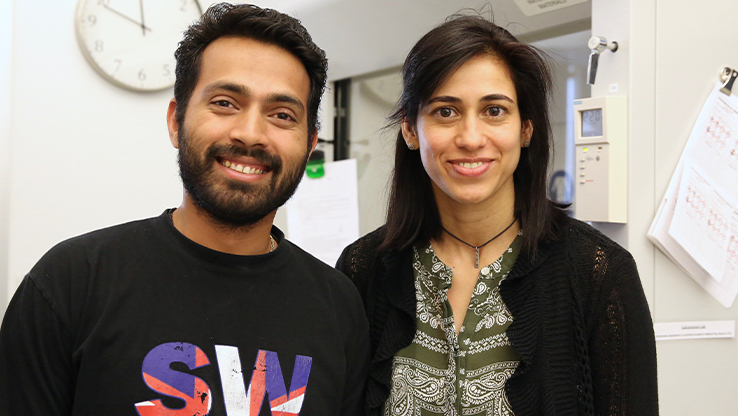How Salmonella Co-Opts the Host Immune System to Conceal Itself
 subramanian.isbscience.org/2020/11/19/how-salmonella-co-opts-the-host-immune-system-to-conceal-itself/
subramanian.isbscience.org/2020/11/19/how-salmonella-co-opts-the-host-immune-system-to-conceal-itself/
ISB Research Scientist Dr. Ajay Suresh Akhade and Assistant Professor Dr. Naeha Subramanian are authors of a paper published in the Proceedings of the National Academy of Sciences (PNAS) that details how Salmonella conceals itself from the immune system. This photo was taken prior to the COVID-19 pandemic.
While scientists have long studied bacterial infections, less attention has been paid to how the host immune response affects bacterial gene expression in the body.
In a just-published paper in PNAS, ISB researchers detailed how the bacterium Salmonella conceals itself from the immune system in a type of host cell called the macrophage. Macrophages are the first responders to Salmonella infection but are also the cells Salmonella uses to spread throughout the body and eventually hijacks for its own survival. They found a complex system where the presence of flagellin – a key part of how Salmonella and other pathogens move around – is identified by a host protein (NLRC4), which triggers an immune response that causes the death of infected cells. This is one way the immune system naturally clears pathogens.
However – and surprisingly – researchers found that as Salmonella infection progresses, two things happen that help the pathogen hide from the immune system: The host produces type 1 interferon that reduces the amounts of NLRC4. At the same time, type 1 interferon also decreases the pool of a type of host lipid that sustains the expression of flagellin. This eventually culminates in less death of infected cells and reduced flagellin amounts in Salmonella, allowing it to avoid recognition by NLRC4 and grow inside host cells.
“These findings shed light on the complex adaptations of Salmonella to its host which dictate the intricacies of host-pathogen interactions,” said Dr. Ajay Suresh Akhade, an ISB research scientist in the Subramanian Lab and lead author of the paper.
‘Constant Evolutionary Arms Race’
This work highlights how host factors impact the expression of bacterial molecules and shape host-pathogen crosstalk. It also emphasizes the need to fully understand how bacterial pathogens have evolved to adapt to and benefit from certain aspects of the host immune response (e.g. type 1 interferons).
“Pathogens are engaged in a constant evolutionary arms race with their hosts,” said Dr. Naeha Subramanian, an ISB assistant professor. “Our findings highlight how Salmonella inadvertently benefits from a natural interferon-dependent host response by turning off expression of its flagellin.”
Future work in this area will be helpful in developing host-directed immunotherapies which can pave the way forward in tackling antimicrobial resistance in the context of bacterial infections. And because the production of type 1 interferons is a bonafide response to virus infections, the interferon-dependent response that Salmonella co-opts to reduce its flagellin and avoid recognition by the immune system may provide one explanation for why people are more prone to secondary bacterial infections after enduring a primary viral infection.




